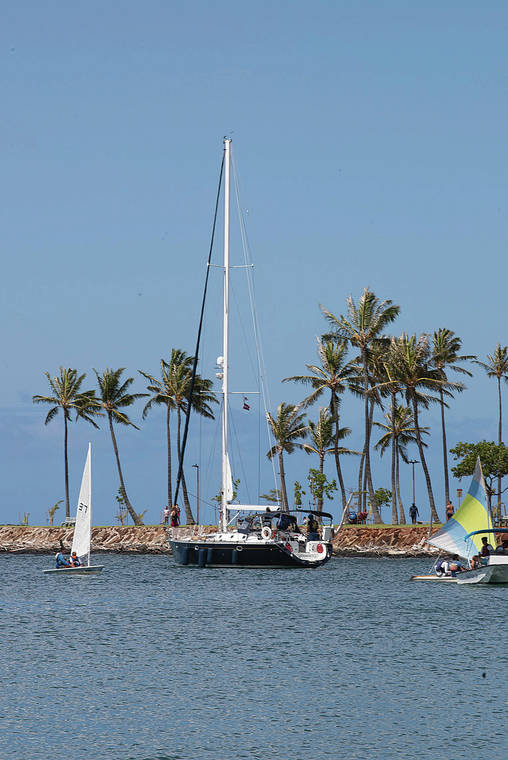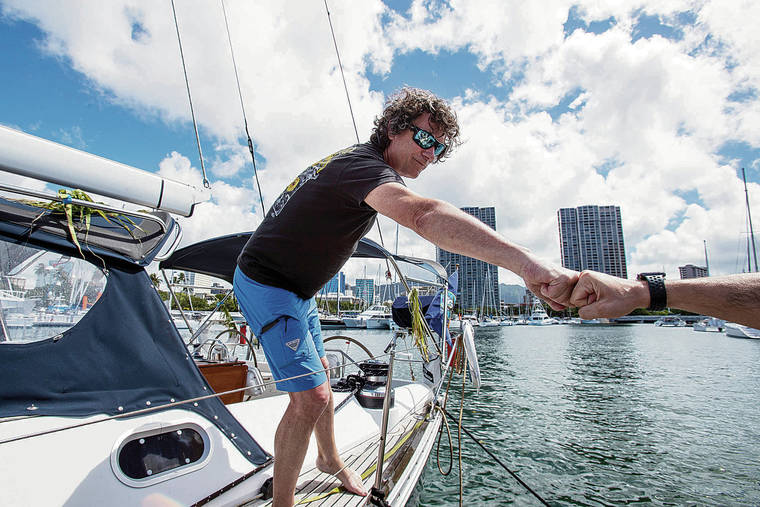A three-person crew left from the Hawaii Yacht Club on Wednesday on a mission to recover the boat of Paralympian Angela Madsen, who died in late June while attempting to row herself from Southern California to Hawaii.
Capt. Russ Johnson is leading the possible two-week mission to locate Madsen’s boat, which is equipped with two transmitters but last sent out its location on Friday, when it got caught in Hurricane Douglas while it was at Category 3 strength.
Her boat, called the Row of Life, is about 750 nautical miles, or over 860 miles, away from Hawaii.
PHOTOS: Crew leaves Waikiki to recover boat of Paralympian who died while rowing from California to Hawaii Opens in a new tab
“We’ve had so much help from experienced people who have towed these row boats, but all of them have never said they’ve never towed … one for a 1,000 miles like we’re going to attempt to do,” he said.
Johnson, along with first mate Janell Clark and Jackie Troller, will spend about five days aboard Johnson’s 52-foot sailboat called Blue Moon, reaching the “hot spot” where Madsen’s boat is likely to be.
Johnson estimated it could take about three days to find the boat and rig it up to the Blue Moon. From there it will take another five days or so to tow the Row of Life, Madsen’s 19-foot boat, across a finish line near Diamond Head in Honolulu, where she would have rowed in.
Madsen, who turned 60 on May 10 during her voyage, was found dead on June 22. After leaving Marina del Rey in California, she had regularly kept in touch with family back home via email and Twitter through a weak satellite connection for about two months.
The last message she sent was posted on June 20 via Twitter, when she said she had to get in the water to fix her para-anchor.
Two days later the Coast Guard located her in the water and tethered to her boat, but she was unresponsive. Her body was recovered shortly after.
Madsen had overcome years of setbacks that started in 1993 after a surgery on her back — which she injured while serving in the military — went wrong and left her unable to walk and forced her to use a wheelchair. She felt “hopeless” and “angry” after that, according to rowoflife.net Opens in a new tab, a website dedicated to the “adventures of Angela Madsen.”
But Madsen went on to compete in the Paralympics with the U.S. National Team three times — most recently in 2016 — and won a bronze medal in shot put in London in 2012. She and her rowing partner finished seventh in a 2008 rowing competition.
Madsen was attempting to be the first paraplegic and oldest woman to row across the Pacific Ocean, according to U.S. Rowing Opens in a new tab. A New York Times article Opens in a new tab said Madsen also would have been the first openly gay athlete to complete the feat.
On Wednesday Madsen’s wife, Debra Madsen, was at the Hawaii Yacht Club — which helped organize the crew and mission — and watched as the Blue Moon set off.
When asked why her wife decided to row across the ocean on her own, Debra Madsen, 57, placed emphasis on her wife’s love of being out on the ocean.
She said Angela Madsen was able to send grainy photos from the Row of Life, which weighed over 1,000 pounds, just about every day, and nearly all the photos were of her on the ocean with a smile on her face.
Others were of her own “Wilson” volleyball, which she brought along and fashioned after the volleyball from the movie “Cast Away.” She also documented a group of fish that followed her for about a month.
“She was quite happy to be out there,” Debra Madsen said. “Every day (she) was happy being in the middle of nowhere.”
Though in the middle of nowhere, Angela Madsen was not alone.
One of the primary reasons to recover Angela Madsen’s boat is to save personal items on board, including a daily video diary of her journey across the ocean.
Because of poor internet quality, Angela Madsen didn’t share those videos online, so the Row of Life contains dozens of videos that the world has yet to see.
“There’s a lot on that boat — her last 60 days of memories. I’m very interested in getting that stuff back, because it would be good for her grandkids,” Debra Madsen said.
That’s one of the primary goals as well for Johnson and the crew.
“I think they’re important to the family and also to preserve the memory of her efforts and the struggles that she went through in life and how she continued to fight and persevere,” he said.
Debra Madsen said those daily videos and the Blue Moon recovery effort could be included in a documentary of Angela Madsen’s voyage that’s being made.




